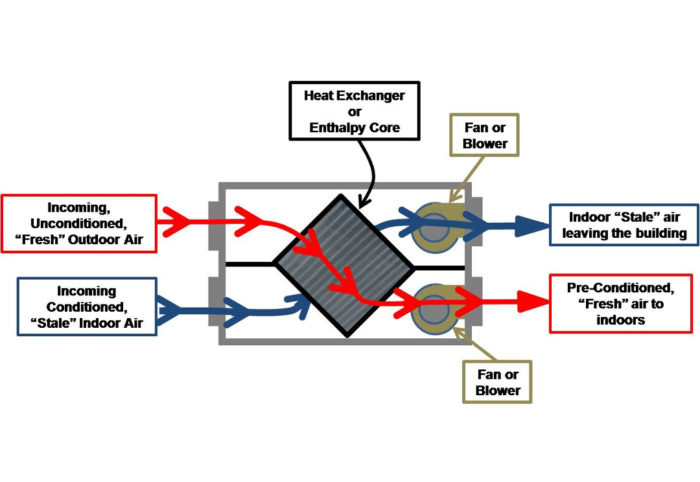The Definitive Guide to HRV Integration in Residential Spaces
Just How Heat Recovery Ventilation Enhances Indoor Air Top Quality and Reduces Energy Prices
Heat Recovery Ventilation (HRV) systems play a necessary function in boosting indoor air top quality while at the same time decreasing energy expenditures. By effectively trading stagnant indoor air with fresh exterior air, HRVs help preserve ideal moisture and reduce contaminants. In addition, their ability to recoup heat from outbound air decreases the stress on heating and cooling systems. As power costs continue to rise, recognizing the complete potential of HRV systems ends up being significantly important for house owners and businesses alike.
Recognizing Heat Recovery Ventilation Solutions

Heat recovery ventilation (HRV) systems play an essential role in improving interior air top quality, particularly in modern, energy-efficient structures. These systems are created to move warm from the outbound stagnant air to the inbound fresh air, consequently reducing energy loss while maintaining perfect temperature degrees indoors. HRVs include a heat exchanger, fans, and ductwork, helping with the continual flow of air. By eliminating indoor toxins and presenting fresh air, HRVs assist to balance humidity degrees, prevent mold development, and reduce irritants. The efficiency of HRV systems hinges on their capacity to recover as much as 80% of the warmth from the tired air, promoting energy preservation while making certain a healthy indoor environment. Their combination is important in accomplishing sustainable living practices.
The Significance of Indoor Air Quality
Indoor air quality (IAQ) is a crucial element influencing the wellness and health of passengers in any type of atmosphere. Poor IAQ can lead to various wellness problems, including respiratory troubles, allergies, and fatigue. In addition, it can worsen status quo such as asthma. Factors adding to low IAQ include pollutants from interior resources like cleansing representatives, mold and mildew, and inadequate air flow. Consequently, keeping great IAQ is vital for advertising a safe and comfy living or working room. Effective methods to improve IAQ entail regular surveillance of air quality, correct ventilation systems, and lessening using harmful compounds inside. By prioritizing IAQ, people can guarantee a much healthier atmosphere that fosters look at here now productivity and overall quality of life.
Energy Efficiency Perks of HRV Equipments
Several house owners and building supervisors are progressively acknowledging the energy efficiency advantages of warm recovery ventilation (HRV) systems. By transferring heat from worn down indoor air to inbound fresh air, HRV systems markedly decrease the power required for heating & cooling. This procedure reduces reliance on conventional a/c systems, bring about reduced energy expenses. Furthermore, HRVs assist maintain a balanced interior environment, protecting against too much home heating or cooling demands. The capacity to recoup approximately 90% of the warm from outward bound air likewise supports sustainability initiatives by lowering general power consumption. HRV systems contribute not just to cost savings but additionally to a decreased carbon footprint, straightening with the expanding emphasis on energy-efficient structure methods.
Installation and Upkeep Considerations
The efficient execution of warmth healing ventilation (HRV) systems requires mindful consideration of installment and upkeep aspects to assure peak performance. Proper positioning of the HRV device is important, as it needs to be mounted in a location that maximizes air movement while reducing sound interruption. Additionally, ductwork needs to be properly sized and protected to avoid energy loss. Regular maintenance, consisting of filter replacement and system cleansing, is critical to protect ideal performance and interior air quality. Owners must develop a regular upkeep routine to determine and attend to possible problems before they rise. Partnership with experienced experts during both installation and maintenance look at more info stages can improve the durability and effectiveness of HRV systems, ultimately resulting in far better interior settings and lowered power prices.
Real-World Applications and Success Stories
Checking out real-world applications of warm recovery air flow (HRV) systems reveals their considerable influence on interior air top quality and energy effectiveness across various setups. In property structures, property owners have reported improved air top quality, causing fewer allergies and breathing concerns. Schools executing HRV systems have actually noted boosted pupil focus and lowered absence as a result of far better air flow. Business structures, such as offices and retail spaces, have experienced reduced power prices and increased worker efficiency. A company office in a temperate climate accomplished a 30% reduction in power bills site web after setting up an HRV system. These success stories demonstrate that HRV technology not only adds to healthier settings but also supplies concrete economic advantages, making it a valuable investment for various markets.
Frequently Asked Concerns
Can HRV Solutions Reduce Allergens in Indoor Air?
The efficiency of HRV systems in minimizing interior irritants largely depends upon their capacity to filter and exchange air. HRV Heat Recovery Ventilation. By continuously changing stale air, these systems can greatly reduce allergen degrees throughout interior atmospheres

Just How Does Moisture Affect HRV System Performance?
Moisture greatly influences HRV system performance; high levels can bring about condensation, lowering effectiveness, while reduced moisture might boost air exchange. Balancing humidity is vital for suitable procedure and keeping interior air top quality.
Are HRV Equipments Noisy Throughout Procedure?
HRV systems can generate varying noise levels during operation, depending on their design and installation. Some units operate silently, while others might create recognizable audio, specifically at greater airflow settings or when poorly kept.
What Is the Ordinary Life-span of an HRV System?

Can HRV Solutions Be Used in All Environments?
HRV systems can be utilized in numerous climates, yet their effectiveness might vary - HRV Heat Recovery Ventilation. In severe temperatures, changes or extra systems may be needed to guarantee excellent performance and convenience while maintaining indoor air top quality